Efficiency Analysis of Artificial Intelligence and Conventional Maximum Power Point Tracking Methods in Photovoltaic Systems
Abstract
1. Introduction
2. Designed Photovoltaic System
2.1. Photovoltaic System
2.2. Battery Energy Storage System (BESS)
2.3. Load
2.4. Environmental Data
| Month | Solar Irradiance (kWh/m2/day) | Temperature (°C) | Sunlight Hours (hours/day) |
|---|---|---|---|
| January | 1.9 | 0.3 | 3.1 |
| February | 2.7 | 2.1 | 4.2 |
| March | 4.0 | 6.7 | 6.1 |
| April | 5.4 | 12.1 | 8.1 |
| May | 6.5 | 17.2 | 10.0 |
| June | 7.3 | 21.5 | 11.0 |
| July | 7.5 | 23.5 | 11.2 |
| August | 6.8 | 23.0 | 10.5 |
| September | 5.4 | 18.5 | 8.5 |
| October | 3.8 | 12.5 | 6.2 |
| November | 2.4 | 6.0 | 4.0 |
| December | 1.8 | 1.0 | 3.1 |
- Solar Irradiance:
- ○
- Solar irradiance directly impacts the energy generation capacity of PV panels.
- ○
- In Ankara, solar irradiance is lowest during the winter months (1.8–1.9 kWh/m2/day in December and January) and peaks during the summer months (7.3–7.5 kWh/m2/day in June and July).
- Temperature:
- ○
- The efficiency of PV cells is temperature-dependent, with higher temperatures typically reducing performance.
- ○
- In Ankara, temperatures range from an average of 0.3 °C in January to 23.5 °C in July.
- Sunlight Hours:
- ○
- Daily sunlight hours determine the duration of energy generation by PV systems.
- ○
- In Ankara, sunlight hours are shortest in winter (3.1 h/day in December and January) and longest in summer (11.0–11.2 h/day in June and July).
2.5. Operation of the System
2.5.1. Energy Generation
2.5.2. Maximum Power Point Tracking (MPPT)
2.5.3. Energy Storage Management
- Charging: if PPV > Pload, the excess energy is used to charge the battery, provided the SOC is below the maximum limit.
- Discharging: if PPV < Pload, the battery supplies the deficit, provided the SOC is above the minimum limit.
2.5.4. Load Management
2.5.5. Performance Evaluation
3. Detailed Analysis of Maximum Power Point Tracking (MPPT) Methods
- ANN-based MPPT method: Provides high accuracy and adaptability but requires a time-intensive training process.
- RL-based MPPT method: Continuously learns and adapts to environmental changes but has a slower initial learning phase.
- Conventional MPPT method: Simple and cost-effective but less effective under rapidly changing conditions. It does not have any adaptation ability.
3.1. ANN (Artificial Neural Network)-Based MPPT Method
- Advantages:
- ○
- Highly accurate predictions.
- ○
- Excellent adaptability to environmental changes.
- Disadvantages:
- ○
- The training process is time-consuming.
- ○
- The performance depends on the quality of the training dataset.
3.1.1. Algorithm and Working Principle
- Input Layer: Takes environmental and system parameters as inputs, such as the following:
- ○
- Solar irradiance.
- ○
- Temperature.
- ○
- Load power.
- Hidden Layers: Processes input data through weights and activation functions. These layers learn the nonlinear relationships in the system.
- Output Layer: predicts the voltage or current at the MPP.
3.1.2. Design Details
- Inputs
- Hidden Layers
- Training Process
- Implementation Considerations
3.2. RL (Reinforcement Learning)-Based MPPT Method
- Advantages:
- ○
- Rapid adaptation to environmental changes.
- ○
- Continuous learning capability.
- Disadvantages:
- ○
- A slow learning process at the beginning.
- ○
- The reward function must be carefully designed.
3.2.1. Algorithm and Working Principle
3.2.2. Design Details
- Inputs (State)
- Action Space
- Q-Table
- Reward Function
- Implementation Considerations
3.3. Conventional MPPT Method
- Advantages:
- ○
- Simple and cost-effective.
- ○
- Low hardware requirements.
- Disadvantages:
- ○
- May become unstable under rapidly changing environmental conditions.
- ○
- Can miss the MPP.
- ○
- A trade-off between the tracking speed and steady-state oscillation is required.
3.3.1. Algorithm and Working Principle
3.3.2. Design Details
- Inputs
- Algorithm Steps
- Implementation Considerations
4. Simulation Results
4.1. Battery State-of-Charge (SOC) Variation
4.2. Monthly PV Energy Production and Efficiency Gains
4.3. Daily Power Profiles
4.4. PV Energy Production Comparison and Efficiency Gains
4.5. Load Reliability
- i.
- Energy production: The RL-based MPPT method consistently outperforms the ANN-based and traditional methods in terms of PV energy production, achieving the highest efficiency gains.
- ii.
- Battery management: The RL and ANN methods effectively manage the battery SOC, minimizing energy losses and prolonging battery lifespan. The conventional method exhibits significant limitations in this regard.
- iii.
- Load reliability: The RL-based MPPT method ensures 100% load reliability, highlighting its potential for real-world applications in which an uninterrupted power supply is critical.
- iv.
- Adaptability: The advanced MPPT methods demonstrate superior adaptability to varying environmental conditions, with the RL method excelling in both summer and winter scenarios.
5. Conclusions
Funding
Institutional Review Board Statement
Informed Consent Statement
Data Availability Statement
Conflicts of Interest
References
- Esram, T.; Chapman, P.L. Comparison of photovoltaic array maximum power point tracking techniques. IEEE Trans. Energy Convers. 2007, 22, 439–449. [Google Scholar] [CrossRef]
- Eyimaya, S.E.; Altin, N. Review of energy management systems in microgrids. Appl. Sci. 2024, 14, 1249. [Google Scholar] [CrossRef]
- Malinowski, M.; Leon, J.I.; Abu-Rub, H. Photovoltaic energy systems. In Power Electronics in Renewable Energy Systems and Smart Grid: Technology and Applications; Wiley-IEEE Press: Hoboken, NJ, USA, 2019; pp. 347–389. [Google Scholar]
- Altin, N.; Eyimaya, S.E. A combined energy management algorithm for wind turbine/battery hybrid system. J. Electron. Mater. 2018, 47, 4430–4436. [Google Scholar] [CrossRef]
- Patel, H.; Agarwal, V. Maximum power point tracking scheme for PV systems operating under partially shaded conditions. IEEE Trans. Ind. Electron. 2008, 55, 1689–1698. [Google Scholar] [CrossRef]
- Mohanty, S.; Mohanty, A.; Mohapatra, A.G.; Gantayat, A.; Kumar, S. Soft Computing Techniques in Solar PV Energy Systems. In Soft Computing in Renewable Energy Technologies; CRC Press: Boca Raton, FL, USA, 2024; p. 32. [Google Scholar]
- Belghiti, H.; Kandoussi, K.; Chellakhi, A.; Mchaouar, Y.; El Otmani, R.; Sadek, E.M. Performance optimization of photovoltaic system under real climatic conditions using a novel MPPT approach. Energy Sources Part A Recovery Util. Environ. Eff. 2024, 46, 2474–2492. [Google Scholar] [CrossRef]
- Anssari, O.M.H.; Badamchizadeh, M.; Ghaemi, S. Designing of a PSO-based adaptive SMC with a Multilevel Inverter for MPPT of PV systems under rapidly changing weather conditions. IEEE Access 2024, 12, 41421–41435. [Google Scholar] [CrossRef]
- Artetxe, E.; Uralde, J.; Barambones, O.; Calvo, I.; Martin, I. Maximum power point tracker controller for solar photovoltaic based on reinforcement learning agent with a digital twin. Mathematics 2023, 11, 2166. [Google Scholar] [CrossRef]
- Abdel-Salam, M.; El-Mohandes, M.T.; Goda, M. An improved perturb-and-observe based MPPT method for PV systems under varying irradiation levels. Sol. Energy 2018, 171, 547–561. [Google Scholar] [CrossRef]
- Sheikh Ahmadi, S.H.; Karami, M.; Gholami, M.; Mirzaei, R. Improving MPPT performance in PV systems based on integrating the incremental conductance and particle swarm optimization methods. Iran. J. Sci. Technol. Trans. Electr. Eng. 2022, 46, 27–39. [Google Scholar] [CrossRef]
- Lasheen, M.; Rahman, A.K.A.; Abdel-Salam, M.; Ookawara, S. Performance enhancement of constant voltage based MPPT for photovoltaic applications using genetic algorithm. Energy Procedia 2016, 100, 217–222. [Google Scholar] [CrossRef]
- Mazumdar, D.; Sain, C.; Biswas, P.K.; Sanjeevikumar, P.; Khan, B. Overview of solar photovoltaic MPPT methods: A state of the art on conventional and artificial intelligence control techniques. Int. Trans. Electr. Energy Syst. 2024, 2024, 8363342. [Google Scholar] [CrossRef]
- Altin, N. Interval type-2 fuzzy logic controller based maximum power point tracking in photovoltaic systems. Adv. Electr. Comput. Eng. 2013, 13, 65–71. [Google Scholar] [CrossRef]
- Datta, S.; Baul, A.; Sarker, G.C.; Sadhu, P.K.; Hodges, D.R. A comprehensive review of the application of machine learning in fabrication and implementation of photovoltaic systems. IEEE Access 2023, 11, 77750–77778. [Google Scholar] [CrossRef]
- Liu, F.; Duan, S.; Liu, F.; Liu, B.; Kang, Y. A variable step size INC MPPT method for PV systems. IEEE Trans. Ind. Electron. 2008, 55, 2622–2628. [Google Scholar]
- Koutroulis, E.; Kalaitzakis, K.; Voulgaris, N.C. Development of a microcontroller-based, photovoltaic maximum power point tracking control system. IEEE Trans. Power Electron. 2001, 16, 46–54. [Google Scholar] [CrossRef]
- Plumb, A.P.; Rowe, R.C.; York, P.; Brown, M. Optimisation of the predictive ability of artificial neural network (ANN) models: A comparison of three ANN programs and four classes of training algorithm. Eur. J. Pharm. Sci. 2005, 25, 395–405. [Google Scholar] [CrossRef]
- Eltawil, M.A.; Zhao, Z. MPPT techniques for photovoltaic applications. Renew. Sustain. Energy Rev. 2013, 25, 793–813. [Google Scholar] [CrossRef]
- Rezk, H.; Eltamaly, A.M. A comprehensive comparison of different MPPT techniques for photovoltaic systems. Sol. Energy 2015, 112, 1–11. [Google Scholar] [CrossRef]
- Yang, Y.; Zhao, F.P. Adaptive perturb and observe MPPT technique for grid-connected photovoltaic inverters. Procedia Eng. 2011, 23, 468–473. [Google Scholar] [CrossRef]
- Kamarzaman, N.A.; Tan, C.W. A comprehensive review of maximum power point tracking algorithms for photovoltaic systems. Renew. Sustain. Energy Rev. 2014, 37, 585–598. [Google Scholar] [CrossRef]
- Abdolrasol, M.G.M.; Hussain, S.M.S.; Ustun, T.S.; Sarker, M.R.; Hannan, M.A.; Mohamed, R.; Ali, J.A.; Mekhilef, S.; Milad, A. Artificial neural networks based optimization techniques: A review. Electronics 2021, 10, 2689. [Google Scholar] [CrossRef]
- Gautam, M. Deep Reinforcement learning for resilient power and energy systems: Progress, prospects, and future avenues. Electricity 2023, 4, 336–380. [Google Scholar] [CrossRef]
- Kumar, A.; Dubey, A.K.; Segovia Ramírez, I.; Muñoz del Río, A.; García Márquez, F.P. Artificial intelligence techniques for the photovoltaic system: A systematic review and analysis for evaluation and benchmarking. Arch. Comput. Methods Eng. 2024, 31, 4429–4453. [Google Scholar] [CrossRef]
- Barutcu, I.C.; Sharma, G.; Gandhi, R.V.; Jadoun, V.K.; Garg, A. Investigations on solar PV integration and associated power quality challenges in distribution systems through the application of MCS and GA. J. Eng. Appl. Sci. 2024, 71, 118. [Google Scholar] [CrossRef]
- Rahman, T.; Al Mansur, A.; Lipu, M.S.H.; Rahman, S.; Ashique, R.H.; Houran, M.A.; Elavarasan, R.M.; Hossain, E. Investigation of degradation of solar photovoltaics: A review of aging factors, impacts, and future directions toward sustainable energy management. Energies 2023, 16, 3706. [Google Scholar] [CrossRef]
- Ledmaoui, Y.; El Maghraoui, A.; El Aroussi, M.; Saadane, R.; Chehri, A.; Chebak, A. PV solar anomaly detection using low-cost data logger and ANN algorithm. Telecommun. Comput. Electron. Control. 2024, 23, 258–266. [Google Scholar] [CrossRef]
- Marangis, D.; Livera, A.; Tziolis, G.; Makrides, G.; Kyprianou, A.; Georghiou, G.E. Trend-Based Predictive Maintenance and Fault Detection Analytics for Photovoltaic Power Plants. Sol. RRL 2024, 8, 2400473. [Google Scholar] [CrossRef]
- Zhang, X.; Li, S.; He, T.; Yang, B.; Yu, T.; Li, H.; Jiang, L.; Sun, L. Memetic reinforcement learning based maximum power point tracking design for PV systems under partial shading condition. Energy 2019, 174, 1079–1090. [Google Scholar] [CrossRef]
- Yang, B.; Yu, T.; Zhang, X.; Li, H.; Shu, H.; Sang, Y.; Jiang, L. Dynamic leader based collective intelligence for maximum power point tracking of PV systems affected by partial shading condition. Energy Convers. Manag. 2019, 179, 286–303. [Google Scholar] [CrossRef]
- Yang, B.; Zhong, L.; Zhang, X.; Shu, H.; Yu, T.; Li, H.; Jiang, L.; Sun, L. Novel bio-inspired memetic salp swarm algorithm and application to MPPT for PV systems considering partial shading condition. J. Clean. Prod. 2019, 215, 1203–1222. [Google Scholar] [CrossRef]
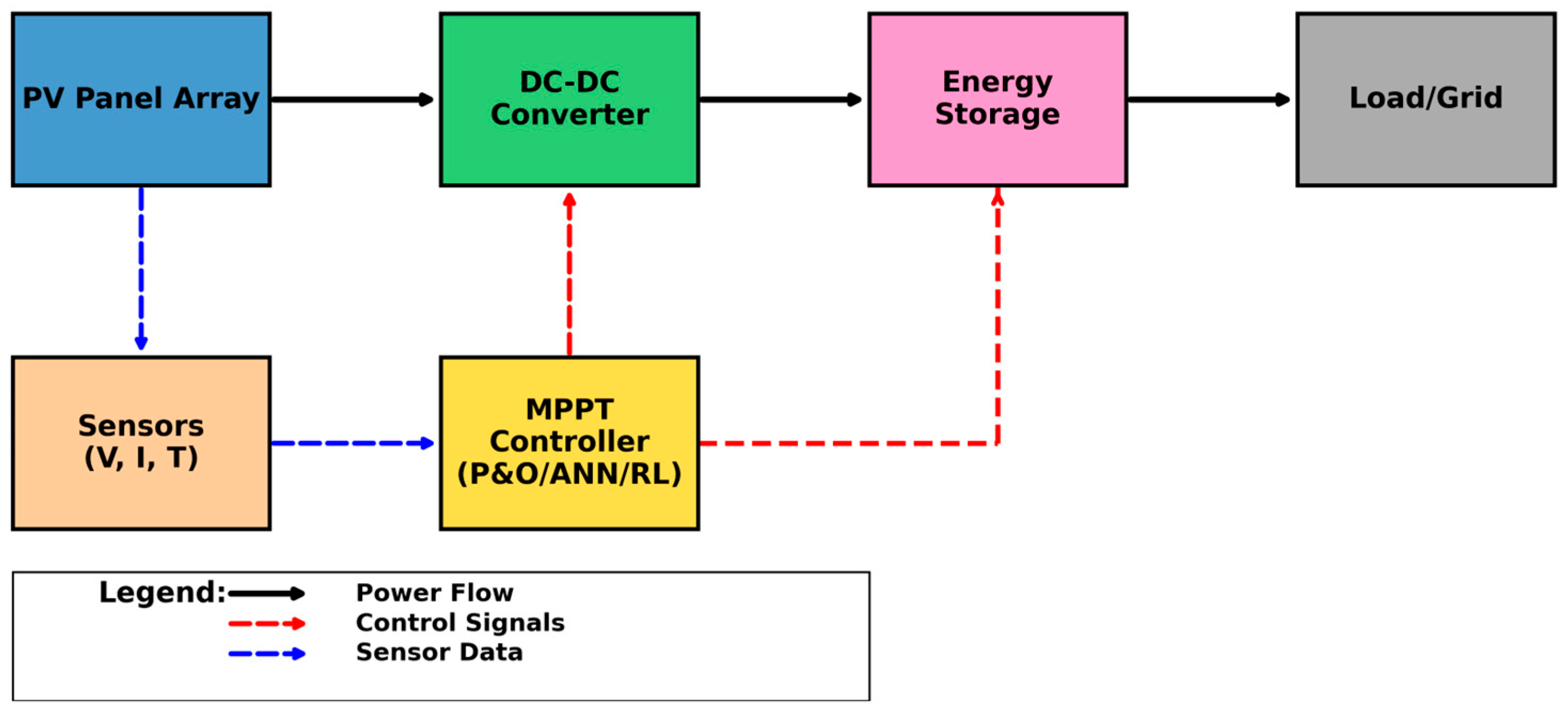
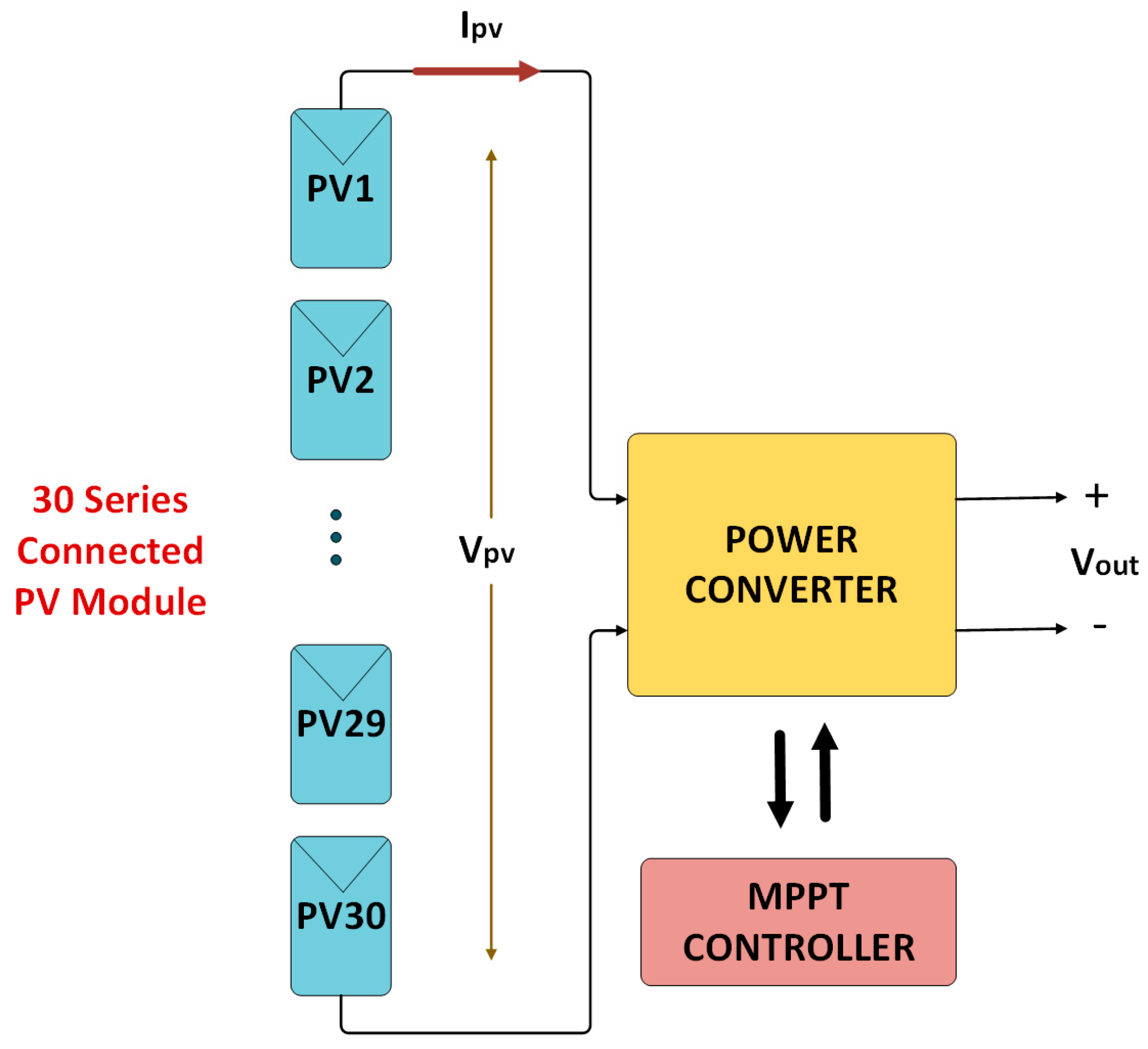
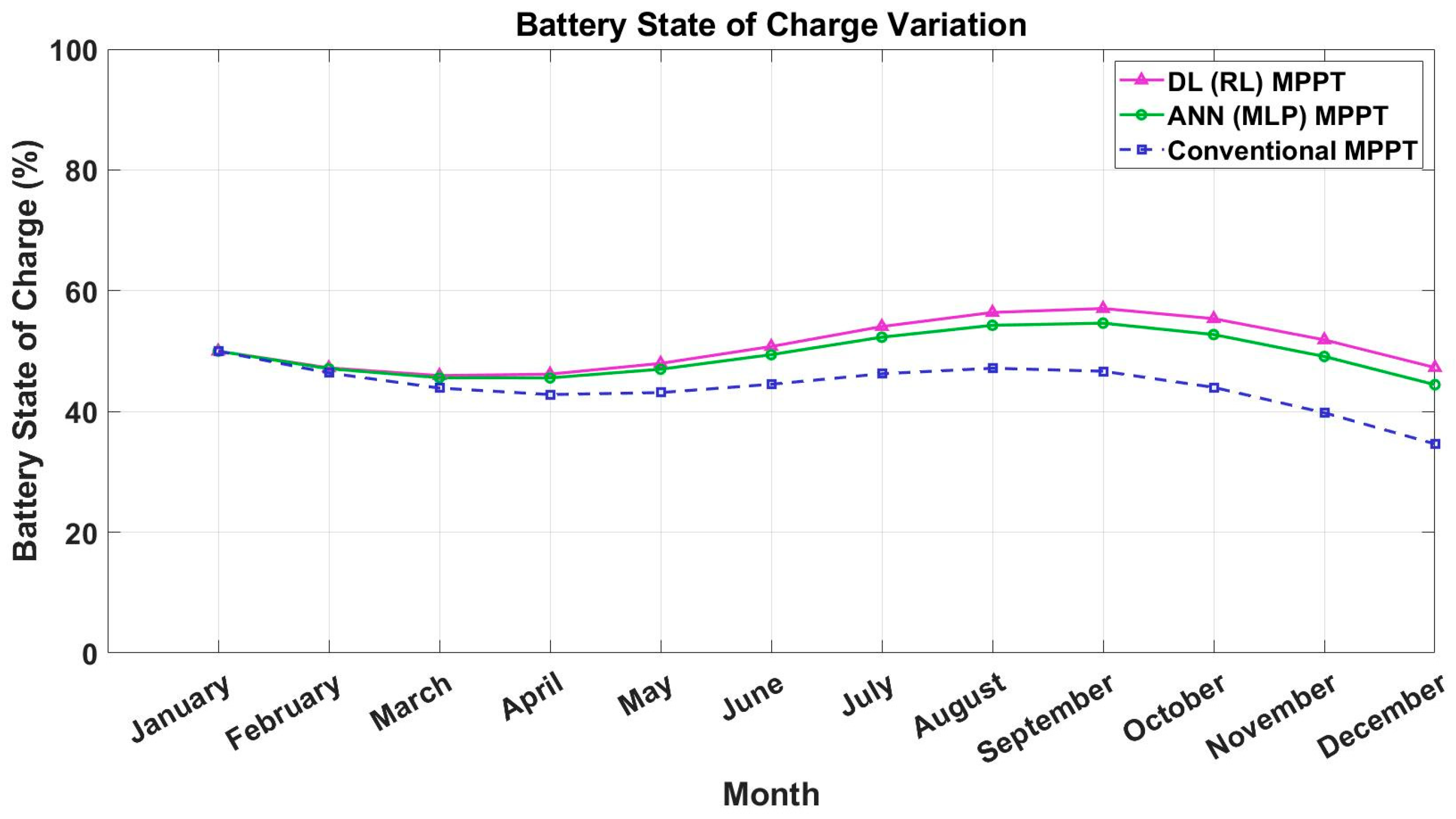

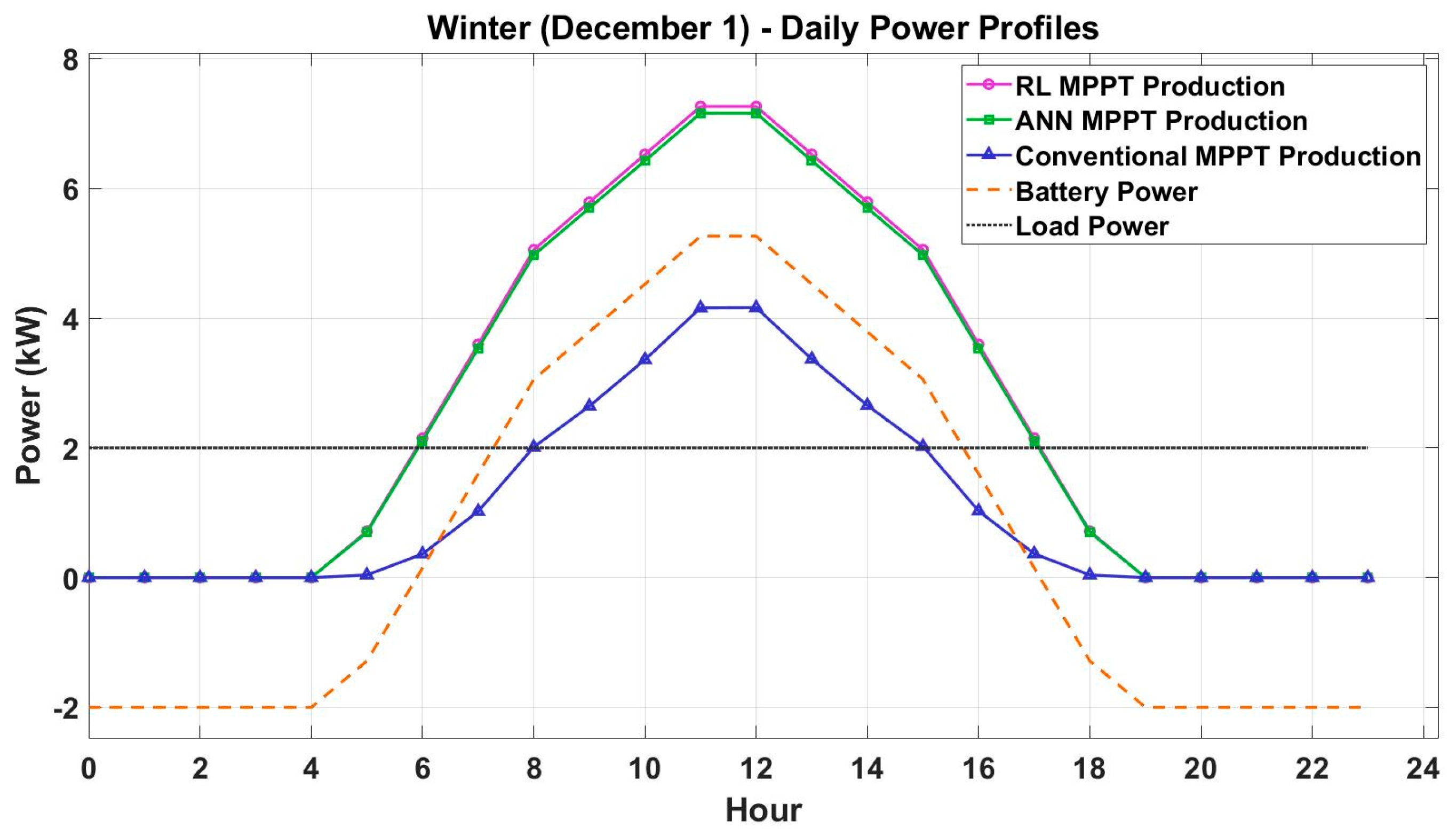
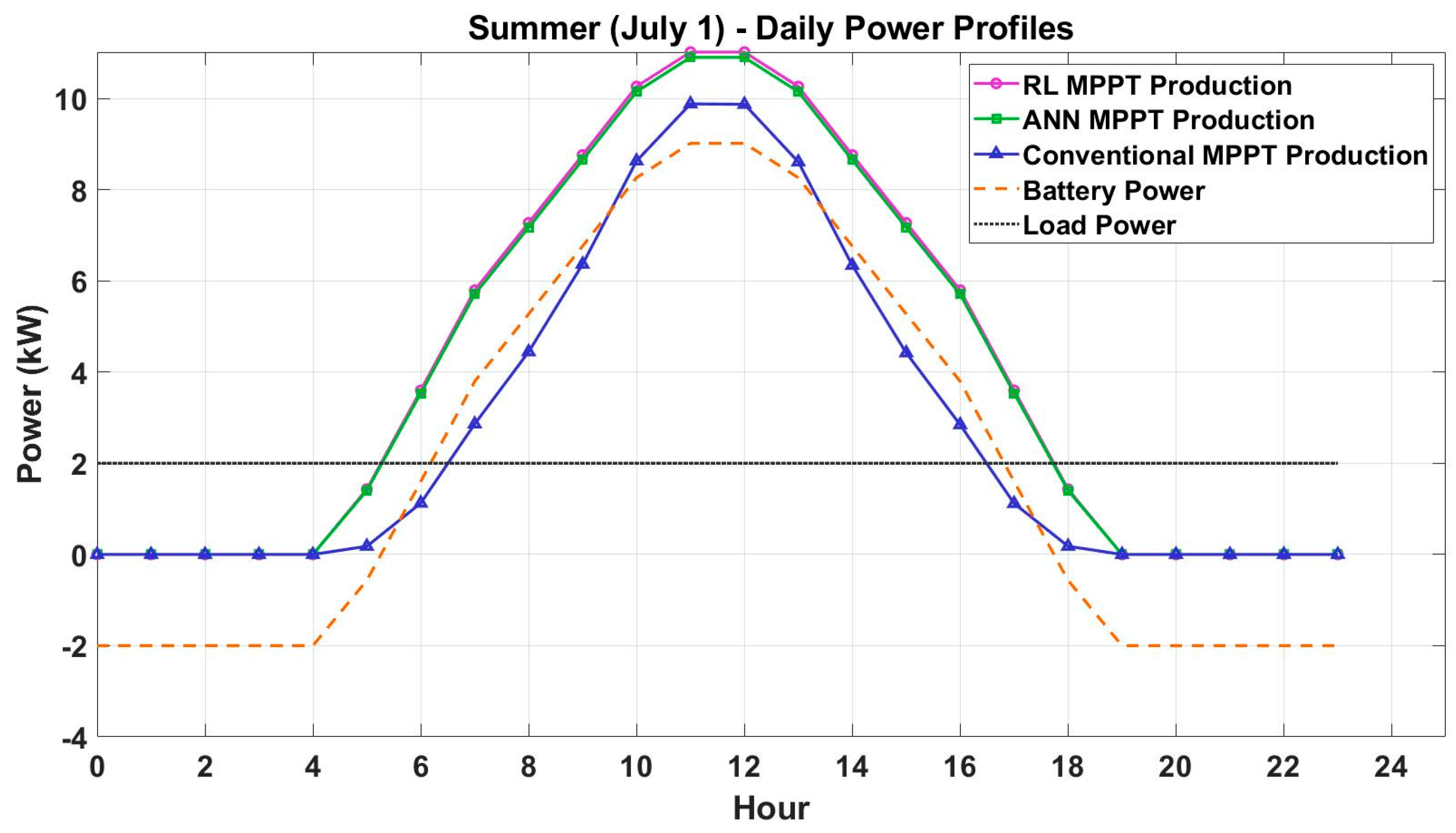
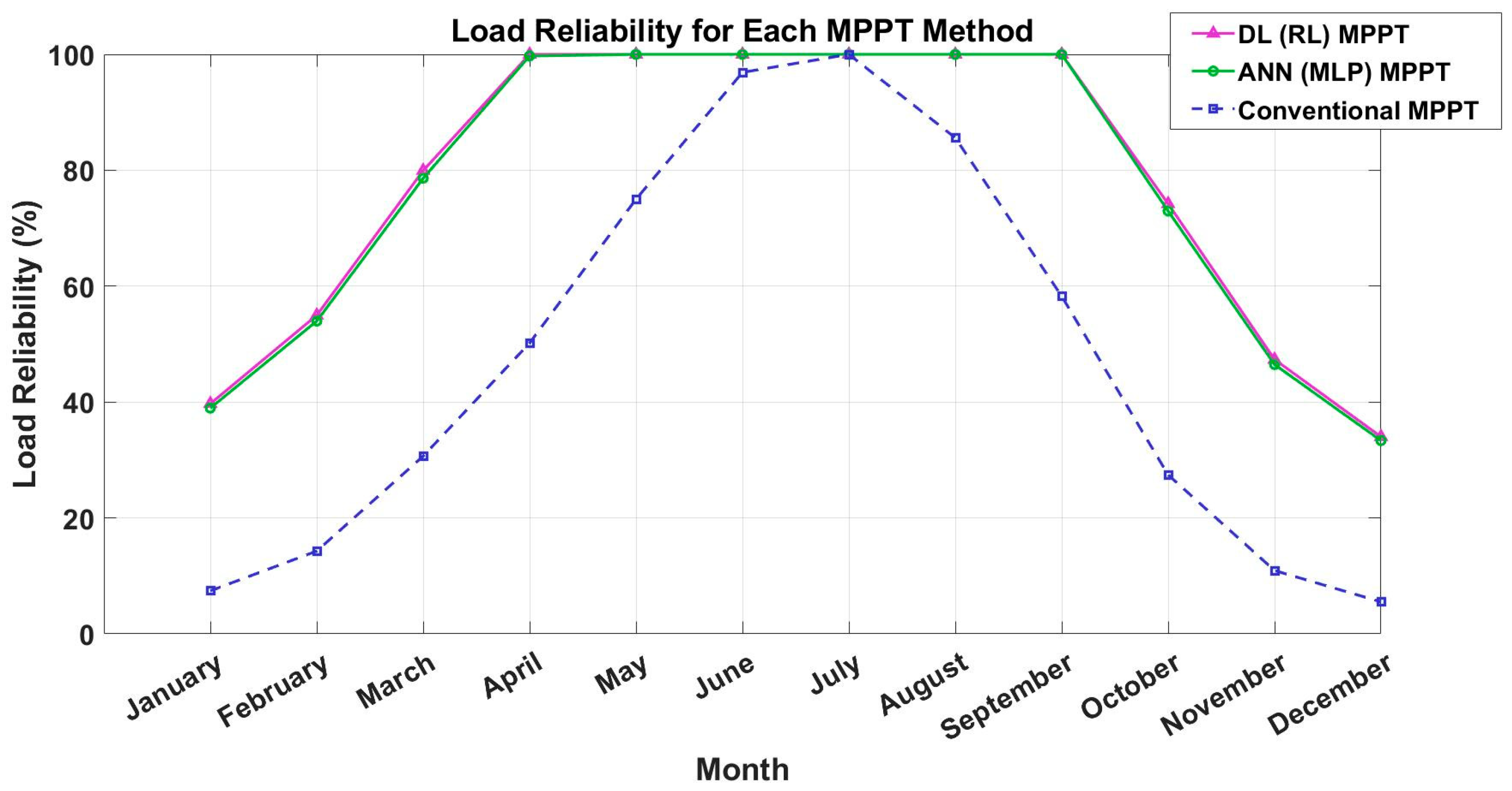
| Method | Accuracy | Adaptability | Complexity | Dynamic Performance |
|---|---|---|---|---|
| P and O | Moderate | Low | Low | Poor |
| ANN-Based | High | High | High | Good |
| RL-Based | Very High | Very High | Very High | Excellent |
| Parameter | Value |
|---|---|
| Power per Panel | 250 W |
| Number of Panels | 30 |
| Total Capacity | 7.5 kW |
| Temperature Coefficient | −0.4%/°C |
| Parameter | Value |
|---|---|
| Capacity | 20 kWh |
| Type | Li-Ion |
| Efficiency | 95% |
| Depth of Discharge (DoD): | 80% |
| State of Charge (SOC) Range: | 20% to 90% |
| Initial SOC | 50% |
| Parameter | Value |
|---|---|
| Power Demand | 2 kW (constant) |
| Daily Energy Consumption | 48 kWh |
| Method | Inputs | Hidden Layers | Output |
|---|---|---|---|
| ANN-based (MLP) | Solar irradiance, temperature, load power | 1 hidden layer, 10 neurons, sigmoid | MPPT efficiency |
| RL-based (Q-Learning) | Solar irradiance, temperature | Q-table for state–action pairs | Optimal action (voltage/current adjustment) |
| Conventional | Voltage, current | None | Adjusted voltage/current |
| Metric | Value |
|---|---|
| Total Annual PV Production (DL-RL MPPT) | 16,069.46 kWh |
| Total Annual PV Production (ANN-MLP MPPT) | 15,448.76 kWh |
| Total Annual PV Production (Conventional MPPT) | 14,637.11 kWh |
| Total Annual Consumption | 17,520.00 kWh |
| DL–Conventional Average Efficiency Difference | 9.72% |
| ANN–Conventional Average Efficiency Difference | 5.56% |
Disclaimer/Publisher’s Note: The statements, opinions and data contained in all publications are solely those of the individual author(s) and contributor(s) and not of MDPI and/or the editor(s). MDPI and/or the editor(s) disclaim responsibility for any injury to people or property resulting from any ideas, methods, instructions or products referred to in the content. |
© 2025 by the author. Licensee MDPI, Basel, Switzerland. This article is an open access article distributed under the terms and conditions of the Creative Commons Attribution (CC BY) license (https://creativecommons.org/licenses/by/4.0/).
Share and Cite
Eyimaya, S.E. Efficiency Analysis of Artificial Intelligence and Conventional Maximum Power Point Tracking Methods in Photovoltaic Systems. Appl. Sci. 2025, 15, 5586. https://doi.org/10.3390/app15105586
Eyimaya SE. Efficiency Analysis of Artificial Intelligence and Conventional Maximum Power Point Tracking Methods in Photovoltaic Systems. Applied Sciences. 2025; 15(10):5586. https://doi.org/10.3390/app15105586
Chicago/Turabian StyleEyimaya, Süleyman Emre. 2025. "Efficiency Analysis of Artificial Intelligence and Conventional Maximum Power Point Tracking Methods in Photovoltaic Systems" Applied Sciences 15, no. 10: 5586. https://doi.org/10.3390/app15105586
APA StyleEyimaya, S. E. (2025). Efficiency Analysis of Artificial Intelligence and Conventional Maximum Power Point Tracking Methods in Photovoltaic Systems. Applied Sciences, 15(10), 5586. https://doi.org/10.3390/app15105586






